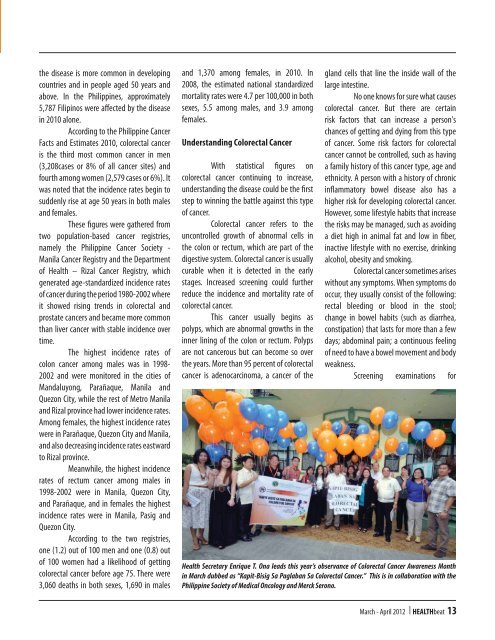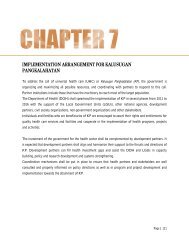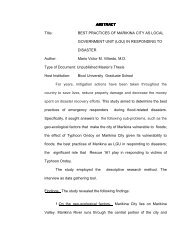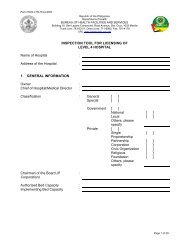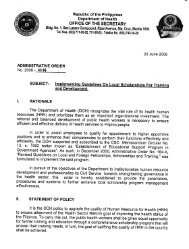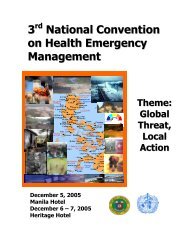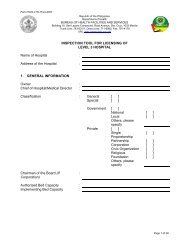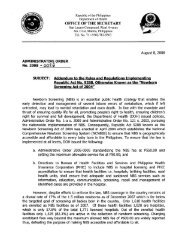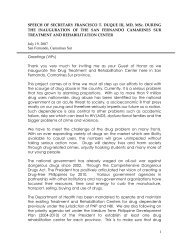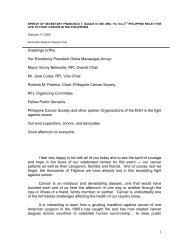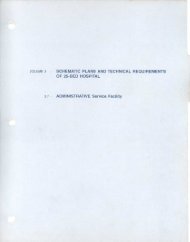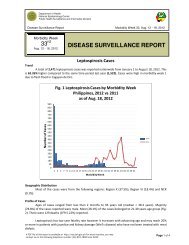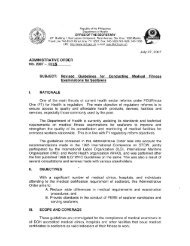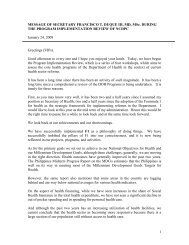Issue No. 69 - March - April 2012 - DOH
Issue No. 69 - March - April 2012 - DOH
Issue No. 69 - March - April 2012 - DOH
- No tags were found...
Create successful ePaper yourself
Turn your PDF publications into a flip-book with our unique Google optimized e-Paper software.
the disease is more common in developingcountries and in people aged 50 years andabove. In the Philippines, approximately5,787 Filipinos were affected by the diseasein 2010 alone.According to the Philippine CancerFacts and Estimates 2010, colorectal canceris the third most common cancer in men(3,208cases or 8% of all cancer sites) andfourth among women (2,579 cases or 6%). Itwas noted that the incidence rates begin tosuddenly rise at age 50 years in both malesand females.These figures were gathered fromtwo population-based cancer registries,namely the Philippine Cancer Society -Manila Cancer Registry and the Departmentof Health – Rizal Cancer Registry, whichgenerated age-standardized incidence ratesof cancer during the period 1980-2002 whereit showed rising trends in colorectal andprostate cancers and became more commonthan liver cancer with stable incidence overtime.The highest incidence rates ofcolon cancer among males was in 1998-2002 and were monitored in the cities ofMandaluyong, Parañaque, Manila andQuezon City, while the rest of Metro Manilaand Rizal province had lower incidence rates.Among females, the highest incidence rateswere in Parañaque, Quezon City and Manila,and also decreasing incidence rates eastwardto Rizal province.Meanwhile, the highest incidencerates of rectum cancer among males in1998-2002 were in Manila, Quezon City,and Parañaque, and in females the highestincidence rates were in Manila, Pasig andQuezon City.According to the two registries,one (1.2) out of 100 men and one (0.8) outof 100 women had a likelihood of gettingcolorectal cancer before age 75. There were3,060 deaths in both sexes, 1,<strong>69</strong>0 in malesand 1,370 among females, in 2010. In2008, the estimated national standardizedmortality rates were 4.7 per 100,000 in bothsexes, 5.5 among males, and 3.9 amongfemales.Understanding Colorectal CancerWith statistical figures oncolorectal cancer continuing to increase,understanding the disease could be the firststep to winning the battle against this typeof cancer.Colorectal cancer refers to theuncontrolled growth of abnormal cells inthe colon or rectum, which are part of thedigestive system. Colorectal cancer is usuallycurable when it is detected in the earlystages. Increased screening could furtherreduce the incidence and mortality rate ofcolorectal cancer.This cancer usually begins aspolyps, which are abnormal growths in theinner lining of the colon or rectum. Polypsare not cancerous but can become so overthe years. More than 95 percent of colorectalcancer is adenocarcinoma, a cancer of thegland cells that line the inside wall of thelarge intestine.<strong>No</strong> one knows for sure what causescolorectal cancer. But there are certainrisk factors that can increase a person'schances of getting and dying from this typeof cancer. Some risk factors for colorectalcancer cannot be controlled, such as havinga family history of this cancer type, age andethnicity. A person with a history of chronicinflammatory bowel disease also has ahigher risk for developing colorectal cancer.However, some lifestyle habits that increasethe risks may be managed, such as avoidinga diet high in animal fat and low in fiber,inactive lifestyle with no exercise, drinkingalcohol, obesity and smoking.Colorectal cancer sometimes ariseswithout any symptoms. When symptoms dooccur, they usually consist of the following:rectal bleeding or blood in the stool;change in bowel habits (such as diarrhea,constipation) that lasts for more than a fewdays; abdominal pain; a continuous feelingof need to have a bowel movement and bodyweakness.Screening examinations forHealth Secretary Enrique T. Ona leads this year’s observance of Colorectal Cancer Awareness Monthin <strong>March</strong> dubbed as “Kapit-Bisig Sa Paglaban Sa Colorectal Cancer.” This is in collaboration with thePhilippine Society of Medical Oncology and Merck Serono.<strong>March</strong> - <strong>April</strong> <strong>2012</strong> I HEALTHbeat 13


